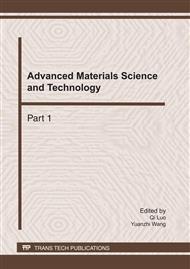[1]
J. X. Dong,M. C. Zhang, X. S. Xie, et al: Materials Science and Engineering . Vol. A328 (2002), pp.8-13.
Google Scholar
[2]
T. D. Xu, B. Y. Cheng: Progress in Materials Science Vol. 49(2004), pp.109-208.
Google Scholar
[3]
McLean D. Grain boundaries in metals. Oxford University Press, (1957).
Google Scholar
[4]
K. T. Aust, R. E. Hanneman, P. Niessen, et al: Acta Metallurgica Vol. 16(1968), pp.291-302.
Google Scholar
[5]
T. R. Anthony: Acta Metallurgica Vol. 17(1969), pp.603-609.
Google Scholar
[6]
T. D. Xu: Journal of Materials Science Vol. 22(1987), pp.337-345.
Google Scholar
[7]
T. D. Xu Xu: Journal of Materials Science Letters Vol. 7(1988), pp.241-242.
Google Scholar
[8]
T. D. Xu, S. H. Song, H. Z. Shi, et al: Acta Metallurgica et Materialia Vol. 39(1991), pp.3119-3124.
Google Scholar
[9]
Q. F. Li, S. L. Yang, L. Li, et al: Scripta Materialia Vol. 47(2002), pp.389-392.
Google Scholar
[10]
P. Sevc, J. Janovec, M. Lucas, et al. Steel Research Vol. 66(1995), pp.537-542.
Google Scholar
[11]
W. Chen, M. C. Chaturvedi, N. L. Richards. Metallurgical and Materials Transactions Vol. 32A(2001), pp.931-939.
Google Scholar
[12]
H. Ohtani, H. C. Feng, C. J. McMahon, et. al: Metallurgical Transactions A Vol. 7(1976), pp.87-101.
Google Scholar
[13]
H. Ohtani, H. C. Feng, C. J. McMahon Metallurgical Transactions A Vol. 7(1976), pp.1123-1131.
Google Scholar
[14]
L.E. Davis, N.C. McDonald, P.W. Palmberg, et al.: Handbook of Auger Electron Spectroscopy, 2nd ed., Physical electronics industries press, Minnesota, (1976).
Google Scholar
[15]
R. G. Faulkner: Journal of Materials Science Vol. 16(1981), pp.373-383.
Google Scholar
[16]
R. E. Hoffman, F.W. Pikus, R. A. Ward, Transaction of American Institute of Mining, Metallurgical, and Petroleum Engineers Vol. 206 (1956), pp.483-486.
Google Scholar
[17]
R. E. Smallman, Modern Physical Metallurgy, Butterworth, London, (1963).
Google Scholar
[18]
S. M. Kim, W. J. L. Buyers, Journal of Physics: Condensed Matter Vol. 8 L (1978), p.103.
Google Scholar
[19]
E. A. Brand and G. B. Brook (ed), Smithells metals reference book, 7th ed., Oxford, London, (1992).
Google Scholar
[20]
S. H. Song, L. Q. Weng: Materials Science and Technology Vol. 21(2005), pp.305-310.
Google Scholar


